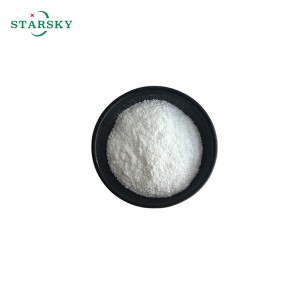Potassium hexafluorotitanate CAS 16919-27-0
Potassium hexafluorotitanate CAS 16919-27-0 is used in a variety of industrial applications, including:
1. Ceramics and Glass: Potassium hexafluorotitanate CAS 16919-27-0 is used as a flux in the production of ceramics and glass, helping to lower the melting point and improve the flow characteristics of the material.
2. Titanium source: used as titanium source in the synthesis of titanium-containing compounds and materials.
3. Electronics: In the electronics industry, it can be used to produce certain types of capacitors and other electronic components.
4. Fluorochemistry: Potassium hexafluorotitanate CAS 16919-27-0 is used in fluorine chemistry to synthesize fluorine compounds.
5. Research: Potassium hexafluorotitanate can also be used in a research environment for various chemical studies and experiments involving titanium and fluorine.
Packed in 25 kg per drum or based on customers' requirements.

Potassium hexafluorotitanate CAS 16919-27-0 should be stored carefully to ensure safety and maintain its stability. Here are some guidelines for proper storage:
1. Container: Store in tightly sealed, labeled containers to prevent contamination and moisture absorption.
2. Storage Location: Please store the container in a cool and dry place, away from direct sunlight and heat sources. Avoid storage in areas with high humidity.
3. Incompatibility: Please keep away from incompatible substances such as strong acids or bases and other active chemicals during storage.
4. Ventilation: Ensure storage areas are well ventilated to minimize the accumulation of any potentially harmful fumes.
5. Access: Limit access to storage areas to only trained personnel who understand the hazards associated with the materials.
6. Emergency Procedures: Have appropriate spill cleanup materials and emergency procedures ready in case of an accidental spill.
Yes, potassium hexafluorotitanate CAS 16919-27-0 can be considered hazardous. Here are some key points about its safety:
1. Toxicity: This compound contains fluoride ions which may be toxic if ingested or inhaled. Fluoride is irritating to the respiratory tract, skin, and eyes.
2. Environmental Impact: Fluoride compounds are harmful to aquatic life and may pose environmental risks if not handled properly.
3. Handling Precautions: When working with potassium hexafluorotitanate, always use appropriate personal protective equipment (PPE), such as gloves, goggles, and masks, to minimize exposure.
4. Storage: Store in a cool and dry place, away from incompatible materials, and in properly labeled containers.


When transporting potassium hexafluorotitanate CAS 16919-27-0, several precautions should be taken to ensure safety and compliance with regulatory requirements. Here are some key considerations to take into account:
1. Regulatory Compliance: Check and comply with local, national and international regulations regarding the transportation of dangerous goods. This may include specific labeling, documentation and packaging requirements.
2. Packaging: Please use suitable packaging materials to ensure that it is moisture-proof and firmly contains the items. Make sure the packaging is strong enough to withstand the handling during transportation.
3. LABELLING: Clearly label packaging with correct hazard symbols and information labels including the correct shipping name, UN number (if applicable), and any relevant hazard warnings.
4. Documents: Prepare and attach all necessary shipping documents such as Safety Data Sheet (SDS), Bill of Lading, and any required dangerous goods declarations.
5. Temperature Control: If necessary, ensure that the method of transportation can maintain appropriate temperature and humidity levels to prevent material degradation or reactions.
6. Training: Ensure that personnel involved in the transportation process are trained in handling hazardous materials and understand the risks associated with potassium hexafluorotitanate.
7. Emergency Procedures: Have emergency response procedures in place to deal with spills or accidents during transport. This includes having a spill kit and emergency service contact information ready.
8. Mode of Transportation: Choose a mode of transportation that minimizes risk and consider using a carrier that has experience handling dangerous goods.









